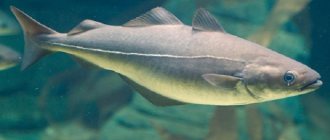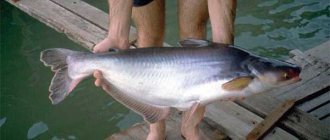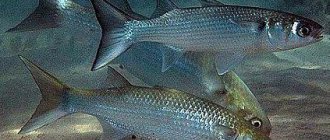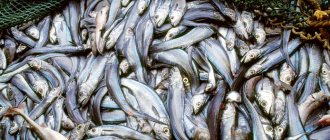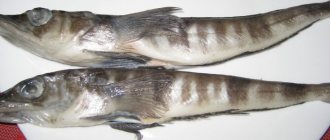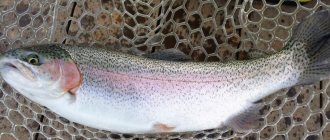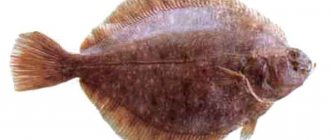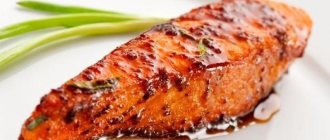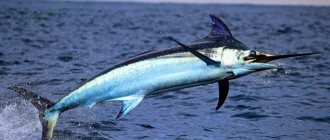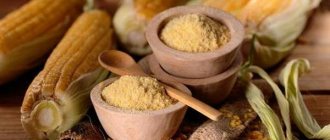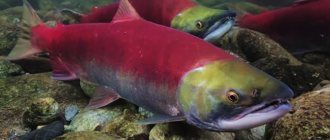Salmon: composition and calorie content
Salmon or Atlantic (lake) salmon, as this representative of the salmon family is also called, is found in the cold waters of the Atlantic Ocean or lakes of the Northern Hemisphere.
The size of the fish sometimes reaches one and a half meters, and the weight can be up to more than 40 kilograms. Tender, tasty pink meat puts the product in the category of delicacies.
The meat of this delicacy contains:
- Squirrels.
- Fats.
- Amino acids.
- Vitamins A, B1, B2, C, E, PP.
- Fatty acids (including Omega-3).
- Potassium.
- Sodium.
- Phosphorus.
- Calcium.
- Iron.
- Methionine.
Due to its low calorie content (only 200-220 Kcal), salmon meat is considered dietary. The methionine content makes the product unique in its benefits.
Useful properties and composition of coho salmon
Meat composition
The meat of this fish contains many minerals and vitamins necessary for the body. There are also almost no small bones in it.
When consumed in small quantities, this meat can be eaten by absolutely everyone, especially children, pregnant women and elderly citizens.
Calorie content
There are 140 kcal per 0.1 kg of product.
Vitamins and minerals
Coho salmon contains the following vitamins: A, C, B1, PP, E, B2 and substances of mineral origin, such as:
- Phosphorus;
- Chromium;
- Nickel;
- Calcium;
- Potassium;
- Zinc;
- Fluorine;
- Sodium;
- Magnesium;
- Iron.
Taste qualities of coho salmon
Compared to other types of salmon, salted coho salmon has the most delicious meat. This is truly an exquisite and delicious fish. Its meat is juicy, aromatic and very tender. It is for this reason that coho salmon is found on the menu of any restaurant.
Conclusion
There are no exact indicators which fish is better: coho salmon or salmon. Taste qualities cannot be a sufficient reason to make a choice towards one of them, since there are approximately equal numbers of lovers of these delicacies.
If you put their beneficial qualities and possible harm on the scales, then we can say that both types are equivalent . A piece of delicacy, prepared in compliance with technology and taking into account existing contraindications, should bring not only gastronomic pleasure, but also tangible health benefits.
What are the benefits and harms of Atlantic (lake) salmon?
Benefit
In addition to the fact that the meat of the inhabitant of cold and clean water is a delicacy and a dietary product, it can have a beneficial effect on vital processes occurring in the body:
- Promotes the production of melatonin, which is responsible for the process of cell renewal and strengthening the nervous system.
- Helps mental activity.
- Strengthens physically, increases the threshold of physical endurance.
- Supplies the body with a complex of essential vitamins and amino acids.
- Strengthens the immune system.
- Prevents the development of cardiovascular diseases (ischemia, stroke, tachycardia, heart attack, atherosclerosis.
- Establishes lipid balance.
- Balances cholesterol and leptin levels.
- Normalizes hormone production.
- Has a rejuvenating effect on the skin.
- Strengthens the bones of the skeleton.
- Improves the condition of interarticular cartilage and ligaments.
- Prevents the harmful effects of radionuclides.
Contraindications
It is difficult to realize that a diet product can be harmful to health. And, nevertheless, contraindications exist. Laboratory studies conducted by American scientists show:
- Fish of this species are capable of accumulating one of the highly toxic mercury compounds - methylmercury . This fact gives grounds to exclude the product from the diet of young children, pregnant and lactating women.
- Due to the high content of extractive components, Atlantic salmon can trigger an allergic reaction. Therefore, allergy sufferers should include such a product in their diet extremely carefully, or exclude it completely.
Attention! The amount of heavy metals in fish (in particular methylmercury) directly depends on the area where it lived and was caught. Another indicator of the content of harmful substances is the size of the marine inhabitant: the greater the length and weight, the higher the percentage of toxins contained.
Pink salmon.
Let's start with the most common type of salmon on sale. And we will immediately introduce concepts that are important for understanding. First of all, you need to understand that all types of wild salmon come from eggs in rivers.
An important characteristic of salmon is its lifespan from the moment it emerges from eggs until the start of spawning, when it is caught commercially in the sea at the approach to the mouths of spawning rivers. So, pink salmon is the fastest-ripening species of salmon. Most pink salmon fry live for less than a year in the river, then slide down the river into the sea and fatten up to adulthood for the same year. It does not go far from the mouth of the rivers in which it appeared. It feeds on what God sends in the coastal waters. In this case, pink salmon reaches a weight of 1-1.5 kg. And she is the one who is caught en masse. Next, it is packaged into briquettes of 10-11 kg. and frozen. At the same time, they try to take specimens of the same size, no more than 1.3 kg. Other specimens are sent for processing (for canning, salting, etc.).
Only a small number of pink salmon live in the river for more than a year (up to two years), and in the sea for 2-3 years. In this case, it grows larger, up to 2-4 kg, but such specimens are not sold frozen.
Pink salmon meat is quite lean, somewhat loose. Therefore, when salting and cutting pink salmon, care must be taken so that the meat does not fall apart and maintains an attractive structure.
Pink salmon caviar is quite small. Without the taste characteristics of other salmon.
Because pink salmon approaches the river mouths quite quickly, then in the mass of fish caught there is a fairly large number of females with immature eggs, i.e. soft and thin walls of eggs. Therefore, during processing and salting, many eggs burst and liquid flows out of them. It is very difficult to give pink salmon caviar a nice grainy appearance. The presence of some liquid in it may not be due to the presence of water. These are just burst eggs.
Taken from open sources
The price of pink salmon is the lowest among salmon. And this is due to the fact that the volumes of its catch are the largest. In Russia, up to 400 thousand tons of pink salmon are caught out of 600 thousand of all salmon caught in the Far East. This explains the prevalence and moderate price of pink salmon caviar.
It must be said that salmon acquire their nuptial plumage when entering spawning rivers. In places of industrial fishing, it is mainly silver in color and males are almost indistinguishable from females. This is how it hits store shelves.
Taken from open sources
I want to note an important point.
Pink salmon is the only type of salmon that is packaged in briquettes, frozen and sold both gutted and ungutted. Because It is not easy even for a specialist to distinguish a female from a male without breeding plumage in a conveyor belt; some females avoid selection for gutting and separation of eggs, but end up in packaging uncut. Many years of experience in purchasing pink salmon in briquettes shows that out of 10 fish, 1 kg each. in a briquette 10 kg. 2 females with eggs. In the female, caviar makes up about 20% of her weight. If you buy 10 kg. ungutted pink salmon at 150 rubles/kg for 1500 rubles, then you get a bonus (cashback) of 400 grams. red caviar at a market price of 800 rubles. Not bad!
